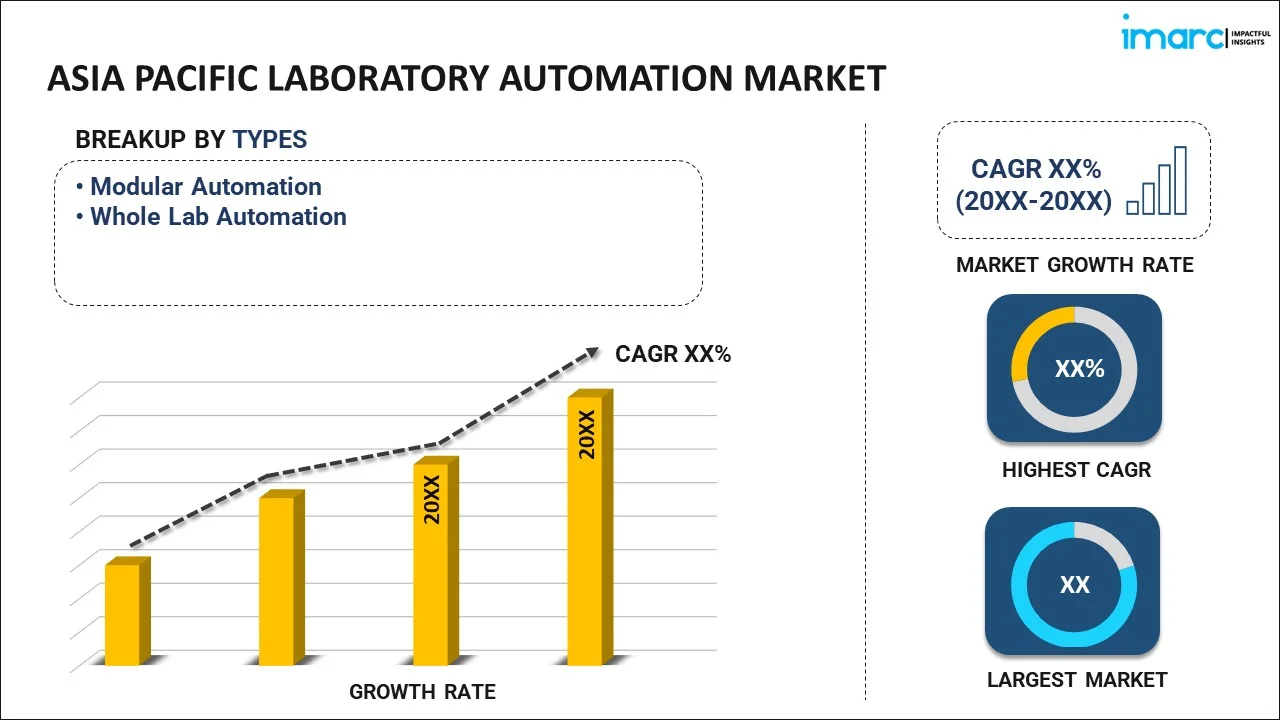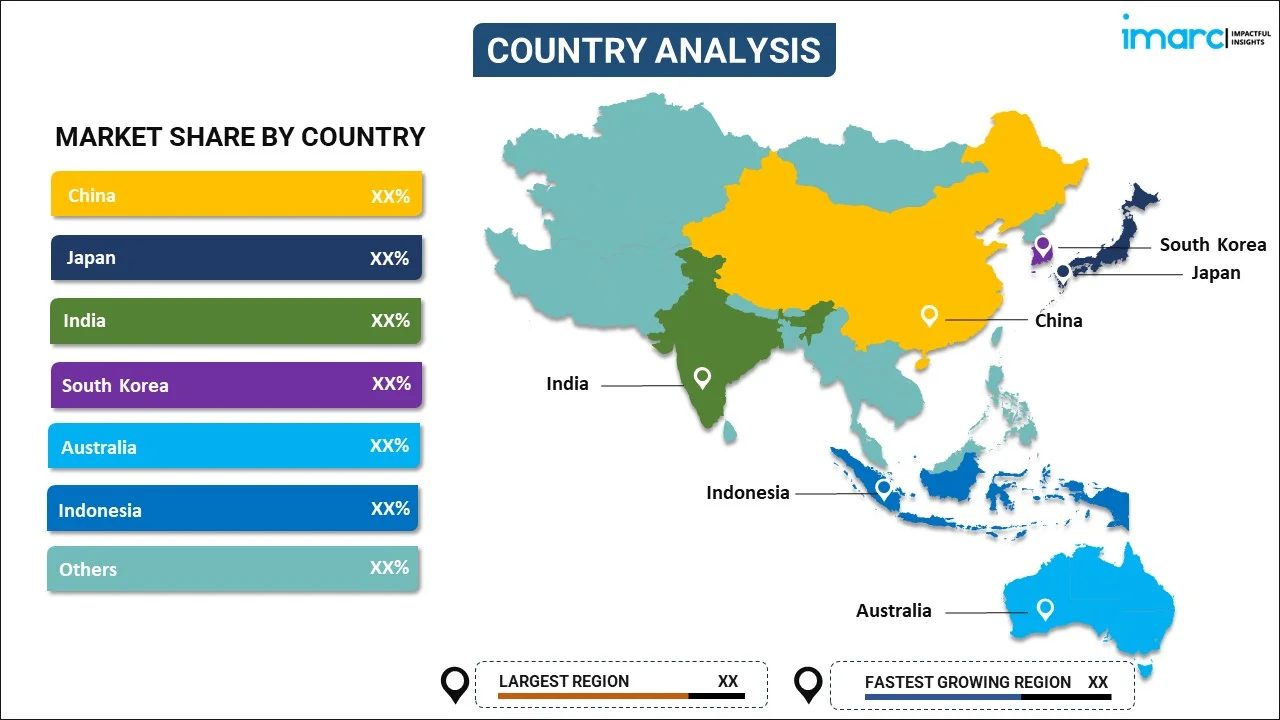
Asia Pacific Laboratory Automation Market Report by Type (Modular Automation, Whole Lab Automation), Equipment and Software Type (Automated Clinical Laboratory Systems, Automated Drug Discovery Laboratory Systems), End User (Biotechnology and Pharmaceutical Companies, Hospitals and Diagnostic Laboratories, Research and Academic Institutes), and Country 2025-2033
Market Overview:
The Asia Pacific laboratory automation market size reached USD 913.0 Million in 2024. Looking forward, IMARC Group expects the market to reach USD 1,769.0 Million by 2033, exhibiting a growth rate (CAGR) of 7.25% during 2025-2033.
|
Report Attribute
|
Key Statistics
|
|---|---|
|
Base Year
|
2024
|
|
Forecast Years
|
2025-2033
|
|
Historical Years
|
2019-2024
|
|
Market Size in 2024
|
USD 913.0 Million |
|
Market Forecast in 2033
|
USD 1,769.0 Million |
| Market Growth Rate 2025-2033 | 7.25% |
Laboratory automation refers to the use of devices and software in laboratories to increase the efficiency of scientific research procedures. It usually comprises robots, machine vision systems, and software that improve the safety and accuracy of sample management. Laboratory automation helps in real-time analysis by eliminating human errors and reducing the human workload. In recent years, laboratory automation has gained traction as it enhances the testing capacity and workflow while minimizing the turnaround time.
Asia Pacific represents one of the largest laboratory automation markets across the globe. The market is primarily driven by improving healthcare facilities, coupled with the increasing number of medical centers with advanced laboratories, across the region. Besides this, the technological revolution in the field of biomedicine and pharmaceuticals has led to the adoption of modular laboratories, offering an economical and reliable solution. Moreover, the rising number of clinical studies, increasing drug discoveries, accurate diagnosis, personnel safety and the smaller volume reagent and sample requirements are some of the advantages associated with laboratory automation. Furthermore, the governments of several countries in the region are investing in research and development (R&D) activities to increase test speeds and reduce the input costs across automated laboratories.
Key Market Segmentation:
IMARC Group provides an analysis of the key trends in each segment of the Asia Pacific laboratory automation market report, along with forecasts at the regional and country levels from 2025-2033. Our report has categorized the market based on type, equipment and software type, and end user.
Breakup by Type:

- Modular Automation
- Whole Lab Automation
Breakup by Equipment and Software Type:
- Automated Clinical Laboratory Systems
- Workstations
- LIMS (Laboratory Information Management Systems)
- Sample Transport Systems
- Specimen Handling Systems
- Storage Retrieval Systems
- Automated Drug Discovery Laboratory Systems
- Plate Readers
- Automated Liquid Handling Systems
- LIMS (Laboratory Information Management Systems)
- Robotic Systems
- Storage Retrieval Systems
- Dissolution Testing Systems
Breakup by End User:
- Biotechnology and Pharmaceutical Companies
- Hospitals and Diagnostic Laboratories
- Research and Academic Institutes
Breakup by Country:

- China
- Japan
- India
- South Korea
- Australia
- Indonesia
- Others
Competitive Landscape:
The competitive landscape of the industry has also been examined along with the profiles of the key players.
Report Coverage:
| Report Features | Details |
|---|---|
| Base Year of the Analysis | 2024 |
| Historical Period | 2019-2024 |
| Forecast Period | 2025-2033 |
| Units | Million USD |
| Segment Coverage | Type, Equipment and Software Type, End User, Country |
| Countries Covered | China, Japan, India, South Korea, Australia, Indonesia, Others |
| Customization Scope | 10% Free Customization |
| Post-Sale Analyst Support | 10-12 Weeks |
| Delivery Format | PDF and Excel through Email (We can also provide the editable version of the report in PPT/Word format on special request) |
Key Questions Answered in This Report:
- How has the Asia Pacific laboratory automation market performed so far and how will it perform in the coming years?
- What has been the impact of COVID-19 on the Asia Pacific laboratory automation market?
- What are the key regional markets?
- What is the breakup of the market based on the type?
- What is the breakup of the market based on the equipment and software type?
- What is the breakup of the market based on the end user?
- What are the various stages in the value chain of the industry?
- What are the key driving factors and challenges in the industry?
- What is the structure of the Asia Pacific laboratory automation market and who are the key players?
- What is the degree of competition in the industry?
Need more help?
- Speak to our experienced analysts for insights on the current market scenarios.
- Include additional segments and countries to customize the report as per your requirement.
- Gain an unparalleled competitive advantage in your domain by understanding how to utilize the report and positively impacting your operations and revenue.
- For further assistance, please connect with our analysts.
 Inquire Before Buying
Inquire Before Buying
 Speak to an Analyst
Speak to an Analyst
 Request Brochure
Request Brochure
 Request Customization
Request Customization




.webp)




.webp)












